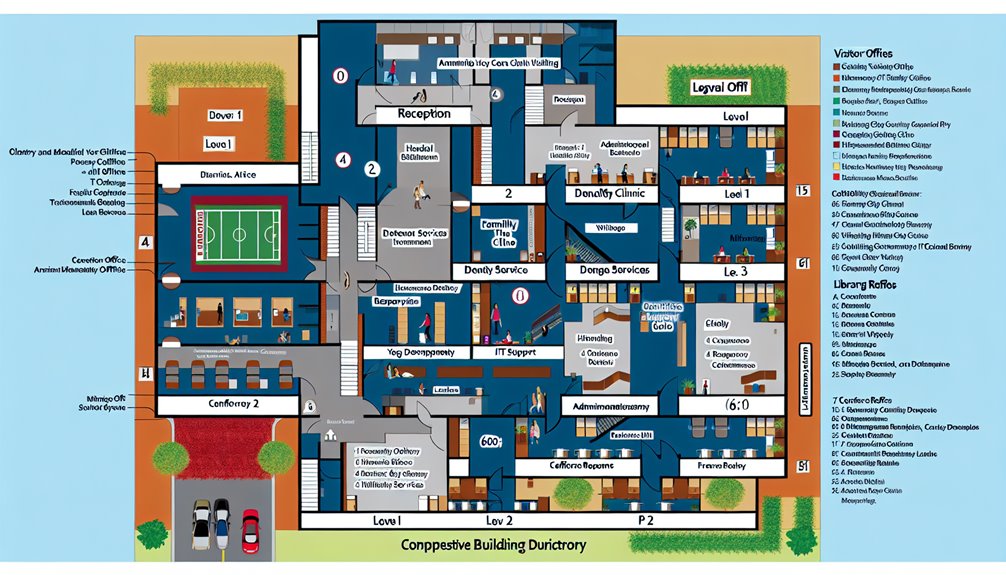In Mission Viejo, we recognize how vital building directory signs are for guiding visitors, boosting safety, and enhancing building aesthetics. Whether it’s metal signs offering durability or digital displays providing real-time information, it’s important that signs are readable, weather-resistant, and comply with local regulations. They are not just functional but also contribute to the building’s identity and user experience, making a strategic investment in quality and design essential. Wall-mounted, freestanding, or digital, each type has its unique appeal and practicality, carefully crafted to meet diverse needs. For those curious about how each sign type can transform a space, further exploration opens up a world of possibilities.
Understanding Directory Sign Basics
In the world of building navigation, directory signs play a fundamental role. We often take for granted how these signs guide us through complex environments like hospitals, office buildings, and educational campuses. The importance of directory signs can’t be overstated; they not only direct traffic efficiently but also enhance safety by confirming that everyone, regardless of familiarity with the building, can find their way.
Choosing the right materials for directory signs is essential. The longevity and visibility of these signs greatly depend on their material composition. Common materials include metal, plastic, and glass, each offering different benefits.
Metal signs, for example, are durable and resistant to weather, making them ideal for both indoor and outdoor use. Plastic signs provide versatility and can be molded into various shapes and sizes, accommodating custom designs. Glass signs, while offering a high-end aesthetic, require careful handling and are best used in less trafficked areas to avoid damage.
As we explore deeper into the specifics of directory sign materials, remember that each choice impacts not only the sign’s functionality but also its integration into the overall design aesthetic of the building. Selecting the right materials guarantees that the directory signs meet both practical needs and design expectations. Modern advancements in sign technology have greatly enhanced the functionality and aesthetic appeal of directory signs, allowing for dynamic digital displays and high-quality materials that ensure durability and visibility.
Design Standards and Regulations
After exploring the various materials used in directory signs and their impact on functionality and aesthetics, we now turn our attention to the design standards and regulations that govern these vital navigation aids.
It’s essential that we guarantee all directory signs meet specific design compliance standards to maintain consistency, safety, and accessibility within Mission Viejo.
These regulations are often mandated by local government bodies to guarantee that signage materials and designs don’t only enhance the environment but are also practical and durable.
For instance, signs must often be made of materials that withstand local weather conditions, and their designs must be clear enough to be easily readable by all, including those with visual impairments.
We must consider factors such as size, color contrast, font style, and illumination.
These elements aren’t just about aesthetics; they play a significant role in how effectively a sign performs its job.
Guaranteeing compliance with these standards isn’t just about following the rules—it’s about creating an environment that’s navigable and user-friendly for everyone.
As we dive deeper, remember, adhering to these regulations helps in maintaining a balance between functionality and visual appeal, making our spaces more accessible and welcoming.
Additionally, Anaheim Signs’ commitment to high-quality materials ensures that their signs not only meet but often exceed local design standards, contributing to the overall durability and effectiveness of business signage in the area.
Types of Directory Signs Available
Exploring the variety of directory signs available, we find that options range from simple wall-mounted directories to freestanding digital kiosks. Each type serves distinct purposes and suits different environments, ensuring effective navigation and information dissemination.
Wall-mounted directories are common in buildings like offices and medical centers, where space efficiency is essential. Typically made from materials like acrylic or metal, they provide a clear, static display of tenant names or room numbers. This traditional approach is cost-effective and straightforward, offering high visibility and ease of maintenance.
For more dynamic interaction, interactive digital directories are transforming how visitors navigate complex spaces like malls or large corporate buildings. These systems respond to user input, offering customized directions and detailed information about each listing. They often integrate with mobile applications, enhancing user experience through seamless digital integration.
Freestanding kiosks, on the other hand, are versatile and can be placed strategically throughout large venues. They often feature touch screens and provide real-time updates, which are invaluable in environments that experience frequent changes, such as conference centers or educational campuses.
Freestanding models blend functionality with aesthetic appeal, contributing to the overall ambiance while offering practical wayfinding solutions.
For businesses looking to enhance their visibility, incorporating high-quality manufacturing in the design of directory signs can significantly impact their effectiveness and durability.
Installation Process and Best Practices
Having covered the types of directory signs available, let’s now focus on how to install them effectively. We must tackle the installation challenges head-on to guarantee longevity and functionality.
First, assess the location. The structural integrity of the wall or surface plays a significant role, as does the visibility from various angles. It’s not just about adhering the sign; it’s about positioning it where it will be most effective.
Next, consider the tools and materials needed. Depending on the sign type, you may require different fasteners, adhesives, or mounting systems. It’s vital to follow the manufacturer’s guidelines to avoid common pitfalls like misalignment or damage to the sign material.
We can’t forget about the maintenance tips that will save us trouble down the line. Regularly cleaning the sign and inspecting its fixtures will help catch any issues before they escalate.
It’s also wise to use materials suited to your building’s environment to prevent premature wear and tear.
Additionally, employing wayfinding signage principles can enhance the effectiveness of directory signs by ensuring they are easily navigable and accessible to all users.
Benefits of Effective Directory Signs
Effective directory signs streamline wayfinding, making it easier for visitors and employees to find their destinations quickly and efficiently. By enhancing the user experience, these signs not only guide but also minimize confusion in large complexes like hospitals, office buildings, and educational campuses.
When signage visibility is optimized, it greatly reduces the time spent wandering through unfamiliar settings, which can be vital in high-stress environments or during emergencies.
We understand that clear, well-positioned directory signs contribute heavily to first impressions. A visitor’s comfort in finding their way in a space reflects on the overall image of the facility. It’s about more than mere direction; it’s about creating a welcoming, accessible environment where everyone feels competent and oriented.
Moreover, effective directory signage supports operational efficiency. Employees save valuable time by not having to assist lost visitors, allowing them to focus on their primary responsibilities. This streamlining of human traffic flow not only enhances productivity but also improves safety by reducing unnecessary congestion in critical areas.
Therefore, investing in high-quality directory signs isn’t just a logistical decision but a strategic enhancement to the functionality and aesthetic appeal of any professional space. We’re committed to helping you achieve this with ideal signage solutions.
Incorporating modern digital displays can further enhance the effectiveness of directory signs by providing real-time updates and interactive features, which are crucial in dynamic environments like airports and shopping centers.
Innovations in Directory Signage
Building on the foundation of traditional directory signs, we’re now seeing remarkable advancements in the technology used for these essential tools. Digital signage is leading the charge, transforming static displays into dynamic, interactive platforms that not only guide but engage users.
We’re talking about signs that can update in real-time, adapting to changes in building layouts or tenant information with a few clicks. This shift towards digital solutions means we’re also embracing interactive maps, which represent a quantum leap from the old directory boards.
Imagine walking into a building and interacting with a touchscreen map that not only shows you your destination but also provides the best route there. These maps can integrate with mobile devices, offering the convenience of sending directions straight to your phone.
Moreover, the integration of software and hardware has enabled us to implement features like voice recognition and gesture control, making directory signs accessible to everyone, including those with disabilities.
It’s clear that the future of directory signage isn’t just about pointing the way, but enhancing user experience through smart, responsive technology. We’re excited to see where these innovations will take us next in creating spaces that are more navigable and inclusive.
Choosing the Right Sign for Your Building
When selecting the right directory sign for your building, it’s vital to take into account both form and function. The materials you choose can drastically influence the durability and appearance. High-quality metals like aluminum or brass are renowned for their longevity and sleek finish, while acrylics offer versatility and modern aesthetics.
It’s important to evaluate where your sign will be placed and what environmental factors it will face.
Color psychology plays a significant role in the effectiveness of your signage. Colors aren’t just about aesthetics; they communicate emotions and information. For instance, blue often conveys professionalism and trust, making it an excellent choice for corporate environments. In contrast, warmer tones like orange and yellow can be welcoming, ideal for residential or hospitality settings.
We understand the importance of making a lasting impression. A well-chosen sign not only guides visitors effectively but also aligns with your building’s identity.
It’s all about finding that perfect balance between practicality and visual appeal. By carefully selecting the right materials and colors, you guarantee your directory sign is both functional and reflective of your brand’s ethos.
Frequently Asked Questions
How Often Should Directory Signs Be Updated?
We recommend updating directory signs whenever there’s a significant change in occupancy or services. Regular sign maintenance guarantees accuracy and efficiency, enhancing navigability and user experience. Ideally, assess update frequency annually to stay current.
Can Directory Signs Include Braille for Accessibility?
Yes, we can include Braille on directory signs to meet accessibility features and comply with Braille regulations. It’s essential for ensuring that visually impaired individuals can navigate spaces independently and safely.
What Is the Typical Cost Range for Directory Signs?
We’ve found that directory signs typically range from $200 to $2,000, depending on material options and installation costs. Mastery of these variables guarantees you make informed decisions that align with your budget and aesthetic requirements.
Are Digital Directory Signs Energy Efficient?
We’ve found that digital directory signs, particularly those using LED technology, generally offer lower energy consumption, making them more energy efficient than traditional models. This efficiency aligns well with sustainable energy goals and practices.
Can Directory Signs Be Customized With a Company Logo?
Yes, we can customize directory signs with your company logo, enhancing your branding opportunities. This custom logo design not only reinforces identity but also offers a professional touch to your business’s presentation.




